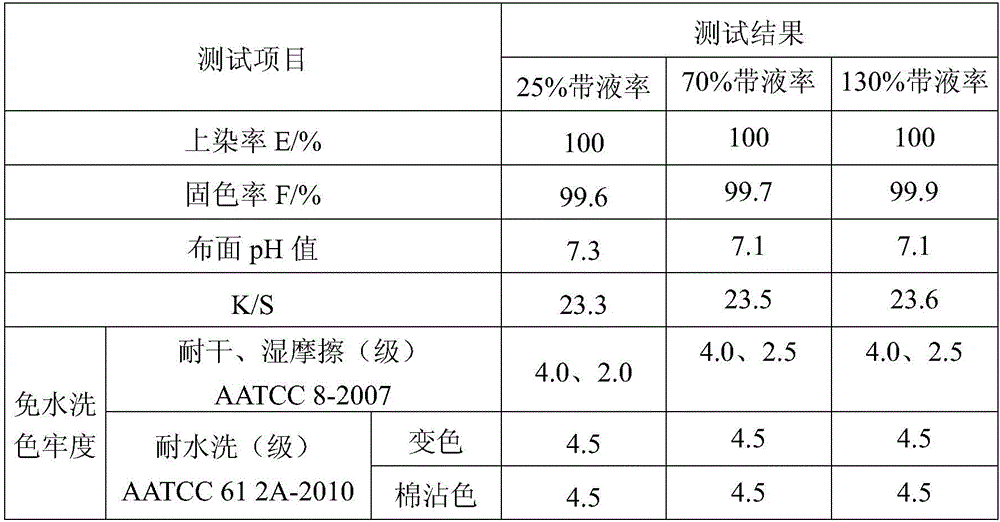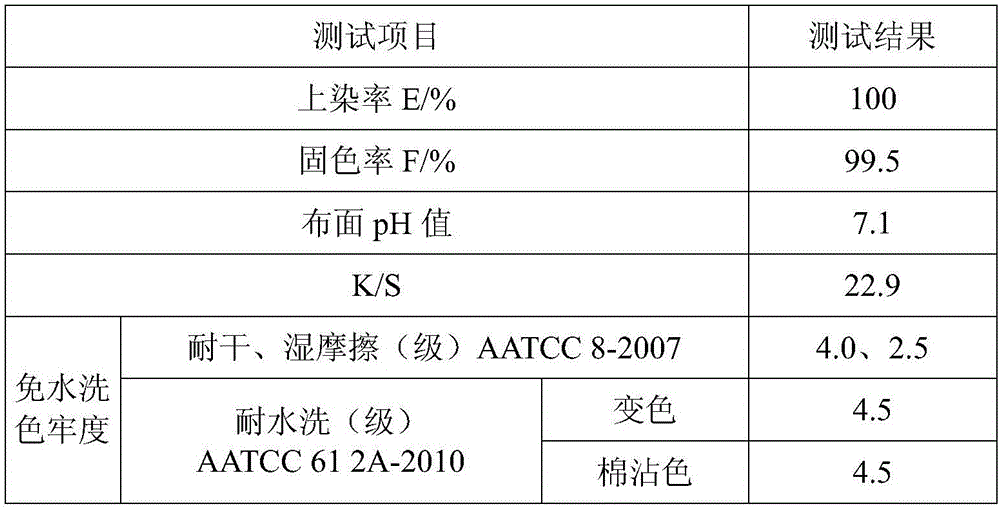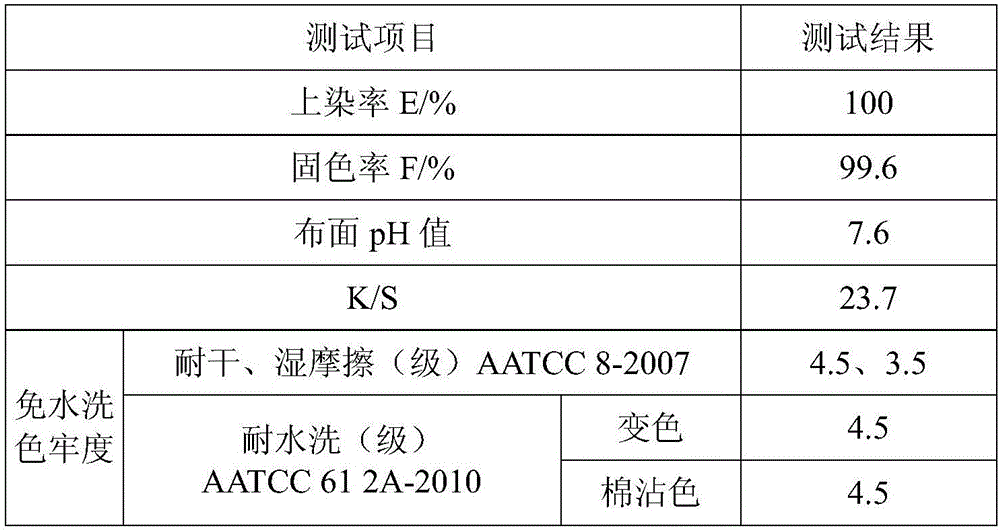Non-aqueous-medium dyeing and washing-free color fixation method for reactive dye
A reactive dye and non-aqueous medium technology, applied in the field of textile dyeing and finishing, can solve the problems of low fixation rate, waste of resources, large amount of surfactant co-surfactant, etc. The effect of reducing water consumption and avoiding hydrolysis reactions
- Summary
- Abstract
- Description
- Claims
- Application Information
AI Technical Summary
Problems solved by technology
Method used
Image
Examples
Embodiment 1
[0044] This embodiment provides a non-aqueous medium dyeing of reactive dyes and a method for water-free color fixing, which comprises the following steps:
[0045] Soak 10g of pure cotton knitted fabric in an aqueous sodium carbonate solution with a concentration of 10g / L to swell, then soak twice and roll twice to control the liquid retention rate to 100%, and bake at 60°C for 10min;
[0046] Put the knitted fabric pretreated by sodium carbonate aqueous solution in the dyeing cup, add 0.3g (3% o.m.f) AviteraRedSE dye, 50mL dimethyl sulfoxide, dye at 50°C, and slowly heat up at 1°C / min Raise the temperature, slowly add 300mL of tetrachlorethylene during the heating process, raise the temperature to 130°C and keep it for 2h;
[0047] The performance test result of the knitted fabric after dyeing and color fixation that table 1 embodiment 1 provides
[0048]
[0049] Take out the dyed cloth sample, dry and recover the solvent, and then evenly atomize 30g / L color fixing agen...
Embodiment 2
[0054] This embodiment provides a non-aqueous medium dyeing of reactive dyes and a method for water-free color fixing, which comprises the following steps:
[0055] Soak 10g of pure cotton knitted fabric in an aqueous sodium carbonate solution with a concentration of 10g / L to swell, then soak twice and roll twice to control the liquid retention rate to 100%, and bake at 60°C for 10min;
[0056] Put the knitted fabric pretreated by sodium carbonate aqueous solution in the dyeing cup, add 0.3g (3% o.m.f) AviteraRedSE dye, 50mL dimethyl sulfoxide, dye at 50°C, and slowly heat up at 1°C / min Raise the temperature, slowly add 300mL of tetrachlorethylene during the heating process, raise the temperature to 130°C and keep it for 2h;
[0057] Take out the dyed cloth sample, dry and recover the solvent, and then foam the working solution containing 60g / L color-fixing agent R-7800 and 10g / L foaming agent CAB through the foaming machine, the foam ratio is 10, and control the foam before a...
Embodiment 3
[0062] This embodiment provides a non-aqueous medium dyeing of reactive dyes and a method for water-free color fixing, which comprises the following steps:
[0063] Soak 10g of cotton / linen (60% cotton + 40% linen) blended knitting fabrics in a sodium carbonate solution with a concentration of 15g / L for 10 minutes at room temperature, dipping and rolling, control the liquid retention rate to 100%, and then dry , the drying temperature is 60°C, and the drying time is 10 minutes;
[0064] Put the knitted fabric pretreated by sodium carbonate solution in the dyeing cup, add 0.3g (3% o.m.f) AviteraRedSE dye, 50mL of N,N-dimethylacetamide, dye at 50°C, and dye at 1°C / min Slowly increase the temperature at a rate of 100%, slowly add 300mL of n-heptane during the heating process, and raise the temperature to 130°C for 2 hours;
[0065] The performance test result of the knitted fabric after dyeing and color fixation that table 3 embodiment 3 provides
[0066]
[0067] Take out t...
PUM
 Login to View More
Login to View More Abstract
Description
Claims
Application Information
 Login to View More
Login to View More - R&D
- Intellectual Property
- Life Sciences
- Materials
- Tech Scout
- Unparalleled Data Quality
- Higher Quality Content
- 60% Fewer Hallucinations
Browse by: Latest US Patents, China's latest patents, Technical Efficacy Thesaurus, Application Domain, Technology Topic, Popular Technical Reports.
© 2025 PatSnap. All rights reserved.Legal|Privacy policy|Modern Slavery Act Transparency Statement|Sitemap|About US| Contact US: help@patsnap.com



